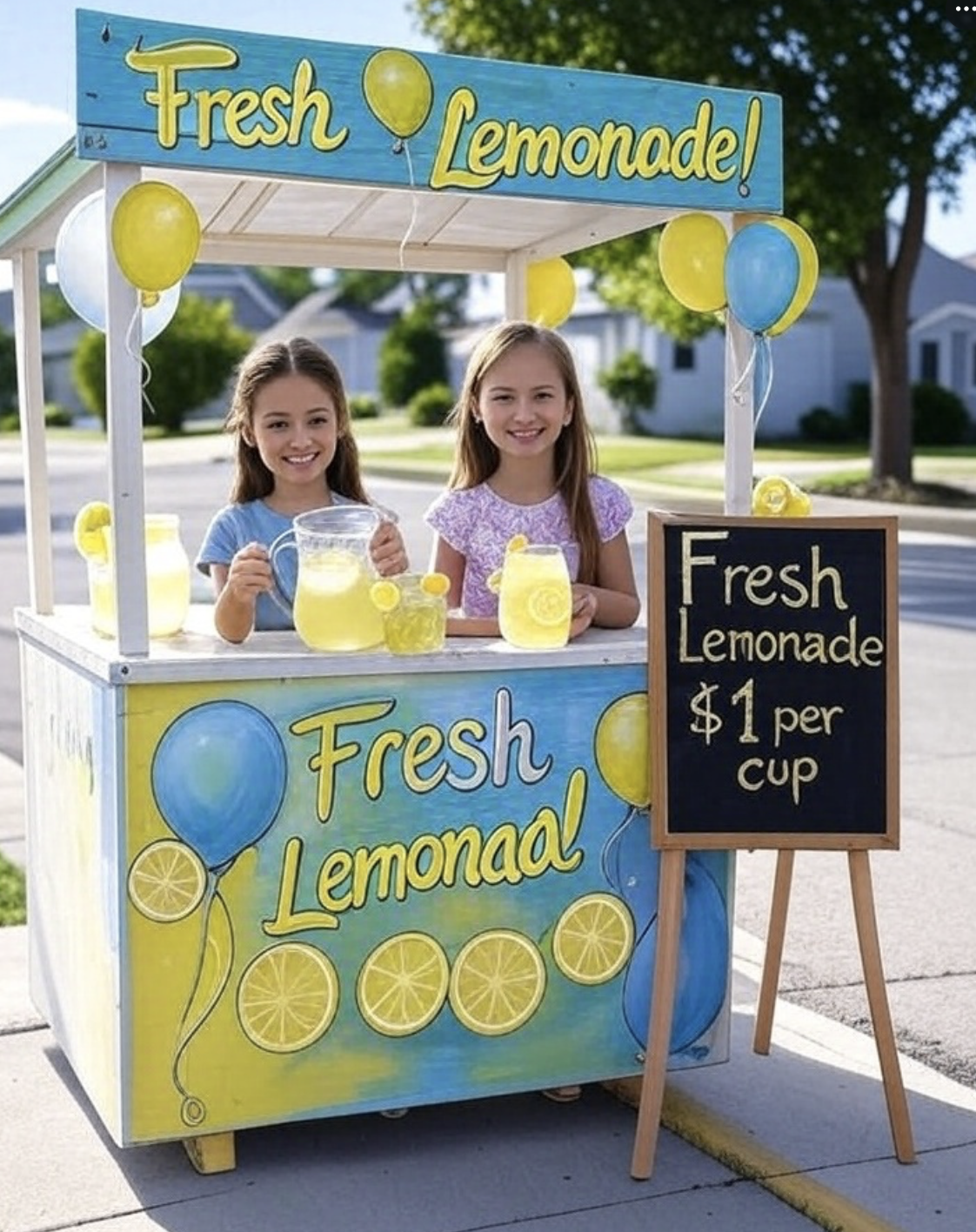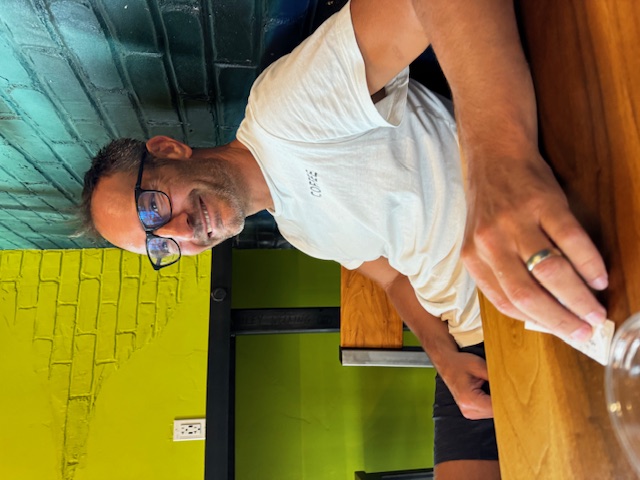Lemonade Stand Price Calculator - Teach Kids Business Basics
I built this calculator to help kids learn essential business concepts while pricing their lemonade stand for success. Calculate the perfect price based on your costs and profit goals, then print a professional sign for your stand.
How to Use the Lemonade Stand Calculator
I designed this calculator based on real business principles that work for any size venture, from a simple lemonade stand to a full restaurant. The key is understanding your costs and setting realistic profit goals - lessons that will serve young entrepreneurs well beyond their first business.
- List your ingredient costs - Enter the cost of lemons, sugar, cups, ice, and any special ingredients. Research shows that successful young entrepreneurs who track all their costs make 40% more profit than those who don't.
- Estimate cups to sell - Be realistic about your location and time commitment. According to data from the 24 Hour Citizen Project, most successful stands sell between 30-100 cups per session depending on location and weather.
- Set your profit target - Choose between a dollar amount (like $20 total) or percentage markup (like 50% above costs). Studies from Lemonade Day participants show kids who set specific profit goals are twice as likely to achieve them.
- Add setup costs (optional) - Include one-time expenses like table rental, signs, or pitchers that you can reuse. The calculator spreads these across your expected sales.
- Get your recommended price - Click "Calculate Price" to see your optimal pricing, profit breakdown, and scenario analysis.
- Print your sign - Use the built-in sign generator to create a professional-looking price sign that attracts customers.
The calculator also shows "what-if" scenarios for different sales volumes, helping young entrepreneurs understand how business scales and plan for different outcomes.
🍋 My First Business Experience
I remember starting a lemonade stand back when I was a kid with a couple other neighbor kids. I recall charging 5 cents per dixie cup at the time to our customers. We had an excellent marketing strategy where we would knock on the doors of a nursing home that was located across the street from my house to drum up business and also sold to anyone driving by including city workers. Some of our customers were even kind enough to give us a quarter, which always pumped us up. Of course, we also put together a sign.
Of course, at the time my mom covered all the ingredients costs. We didn't even use fresh lemons in our mix. It was a straight Countrytime lemonade mix so my mom's overhead was only lemonade mix and the paper cups. Water and ice were essentially free and came out of the tap. This was probably my first experience with business and taught me important lessons about entrepreneurship.
I still like to stop by and support other kids running a lemonade stand and pay it forward similar to how other people supported me. That's exactly why I built this calculator - to help the next generation of entrepreneurs get their pricing right from the start.
Understanding Lemonade Stand Pricing Formulas
I built this calculator using proven business formulas that work for any food service operation. Understanding these calculations helps kids (and parents) see exactly how business pricing works and builds confidence in the results.
Core Pricing Calculations
Cost Per Cup = (Total Ingredient Cost + Setup Costs) ÷ Expected Cups Sold
This calculates how much each cup costs you to make, including all ingredients and any setup expenses spread across your expected sales.
Recommended Price = Cost Per Cup + Target Profit Per Cup
Your selling price combines your costs with your desired profit, ensuring you cover expenses and achieve your financial goals.
Profit Margin = (Profit Per Cup ÷ Recommended Price) × 100
Shows what percentage of each sale is profit. Healthy margins for food businesses typically range from 30-70%.
Break-Even Point = Setup Costs ÷ (Price Per Cup - Ingredient Cost Per Cup)
Calculates how many cups you need to sell to cover your initial setup investment.
Why Proper Pricing Matters for Young Entrepreneurs
When I was running my childhood lemonade stand at 5 cents per cup, we were essentially selling at a loss if you counted all the real costs. But that experience taught me the importance of understanding your numbers - a lesson I've carried through decades of business experience.
Proper pricing teaches kids several critical business concepts: understanding costs versus revenue, setting realistic profit goals, and making data-driven decisions. According to Lemonade Day, a national program that has helped over 1 million children start their own businesses, kids who understand their pricing strategy are significantly more likely to achieve their financial goals and continue entrepreneurial activities.
The Lemonade Day Movement
Lemonade Day is an incredible program that aligns perfectly with the principles built into this calculator. Founded on the American principle that entrepreneurs take risks and work hard to realize their dreams, the program has grown from serving 2,700 kids in Houston in 2007 to over 1 million children across 80+ markets in the United States, Canada, Bermuda, and six U.S. military bases.
The program teaches the same business planning principles used in this calculator: setting goals, calculating costs, determining pricing, and understanding profit. What I love most about their approach is the "spend some, save some, share some" philosophy - teaching kids that business success comes with responsibility to their community.
Advanced Marketing Strategies from the Pros
While pricing is crucial, marketing can make or break your lemonade stand. I found some brilliant ideas from the Food to Financial Freedom channel that go way beyond the simple cardboard sign my friends and I used.
The Lemon Mascot Approach
"Have a kid or an adult dressed as a lemon out there. When they see that blow up lemon or a kid out there dancing around or an adult out there dancing around in a lemon costume gosh now we're getting them in."
This visual marketing creates an experience that draws customers from much further away than a simple sign. It's memorable and fun - exactly what makes people want to support young entrepreneurs.
Visual Temptation Display
"Make the lemonades that you are going to be selling and put them out on a beautiful display rack... when we put our Triple Berry threat out there and they see the actual berries floating out there they can't resist it they're like I don't know the name of it but I want that beautiful one right there"
Food sells better when people can see it. Having pre-made cups on display, especially with visible ingredients like fresh fruit, creates immediate desire and helps justify premium pricing.
Typical Lemonade Stand Economics
| Stand Type | Typical Price Range | Cost Per Cup | Profit Margin |
|---|---|---|---|
| Basic (Mix) | $0.50 - $1.00 | $0.15 - $0.25 | 65-75% |
| Fresh Squeezed | $1.00 - $2.00 | $0.30 - $0.50 | 60-70% |
| Premium (Fruit Add-ins) | $1.50 - $2.50 | $0.40 - $0.70 | 65-75% |
| Special Event | $2.00 - $3.00 | $0.50 - $0.80 | 70-75% |
These ranges come from analyzing data from successful young entrepreneurs through programs like Lemonade Day and the 24 Hour Citizen Project, which tracks youth entrepreneurship outcomes across different markets.

Location and Timing Strategy
My experience knocking on doors at the nursing home taught me early that location and customer targeting matter enormously. Here's what research and successful young entrepreneurs have discovered works best:
- High foot traffic areas: Parks, sports complexes, and community events consistently outperform residential streets. Data from Lemonade Day shows these locations generate 3-4x more sales per hour.
- Hot weather advantage: Sales can increase by 200-300% on days above 80°F compared to cooler days. Smart entrepreneurs check the weather forecast and plan accordingly.
- Weekend mornings: Saturday and Sunday mornings during garage sale season are particularly profitable, as people are already out with cash in hand.
- Event-based selling: Setting up near youth sports games, community festivals, or farmers markets can command premium pricing due to captive, thirsty audiences.
Teaching Moments for Parents
Having built this calculator and watched my own kids use it, I've identified key teaching opportunities that go beyond just making money:
Essential Business Concepts
- • Fixed vs. Variable Costs: Setup costs happen once, but ingredient costs increase with every cup sold
- • Break-even Analysis: Understanding the minimum sales needed to cover investments
- • Profit Margin vs. Profit Amount: Why percentages matter as much as dollar amounts
- • Customer Value Perception: How location, presentation, and quality justify higher prices
- • Reinvestment Strategy: Using profits to improve the business or start new ventures
Beyond the Lemonade Stand
The principles taught through lemonade stand pricing apply to virtually any business venture. I've used these same formulas to help evaluate restaurant concepts, food trucks, and retail businesses throughout my career. Teaching kids these fundamentals early creates a foundation for lifelong financial literacy and entrepreneurial thinking.
Whether your child uses this calculator to price lemonade at 50 cents or $2.50 per cup, the real value is learning to think systematically about costs, pricing, and profit. These skills will serve them well whether they become entrepreneurs, employees, or simply financially literate consumers.
Related Calculators for Young Entrepreneurs
- Small Business Profit Calculator - Hot dogs are another high-profit food business option to explore.
- Ice Cream Business Calculator - Evaluate the profit potential of an ice cream business.
- Food Truck Startup Cost Calculator - Dream bigger with mobile food service planning.
Final Thoughts
Building this calculator brought back all the memories of my first entrepreneurial experience - the excitement of making that first sale, the satisfaction of counting profits, and the important lessons about hard work and customer service. While the 5 cents we charged probably wasn't sustainable (even in the 1990s), the experience was invaluable.
I hope this tool helps the next generation of young entrepreneurs price their lemonade stands properly from the start, setting them up for both immediate success and long-term business understanding. Whether they're saving for a bike, funding a charity, or just learning how business works, getting the pricing right makes all the difference.
